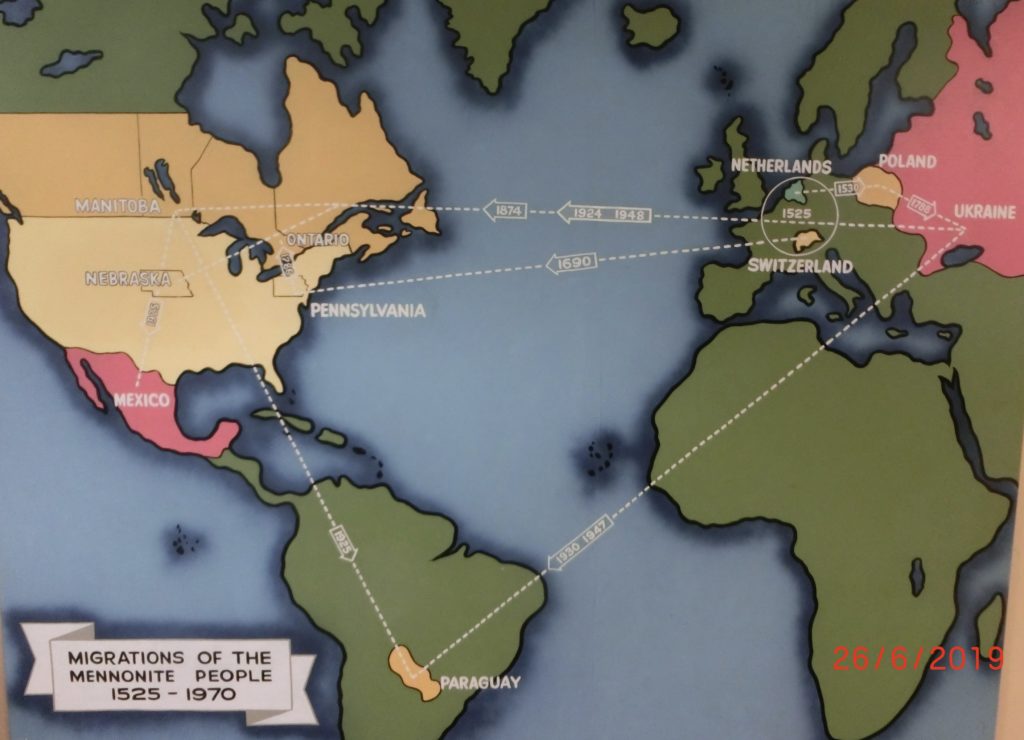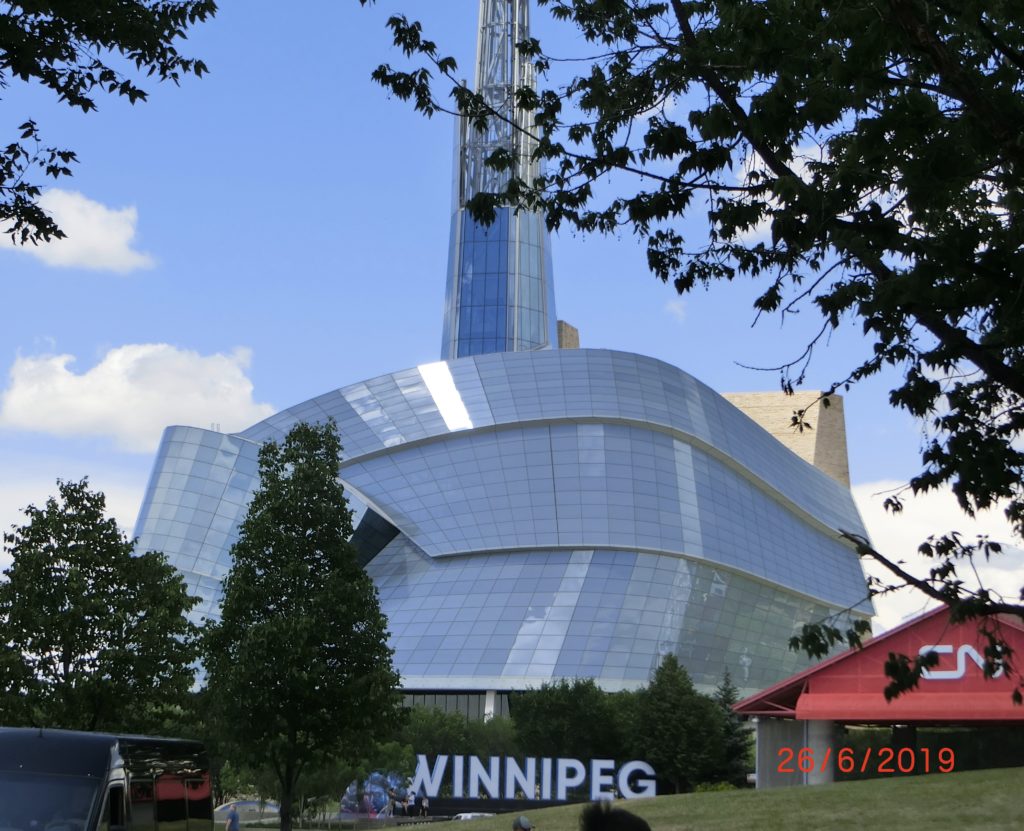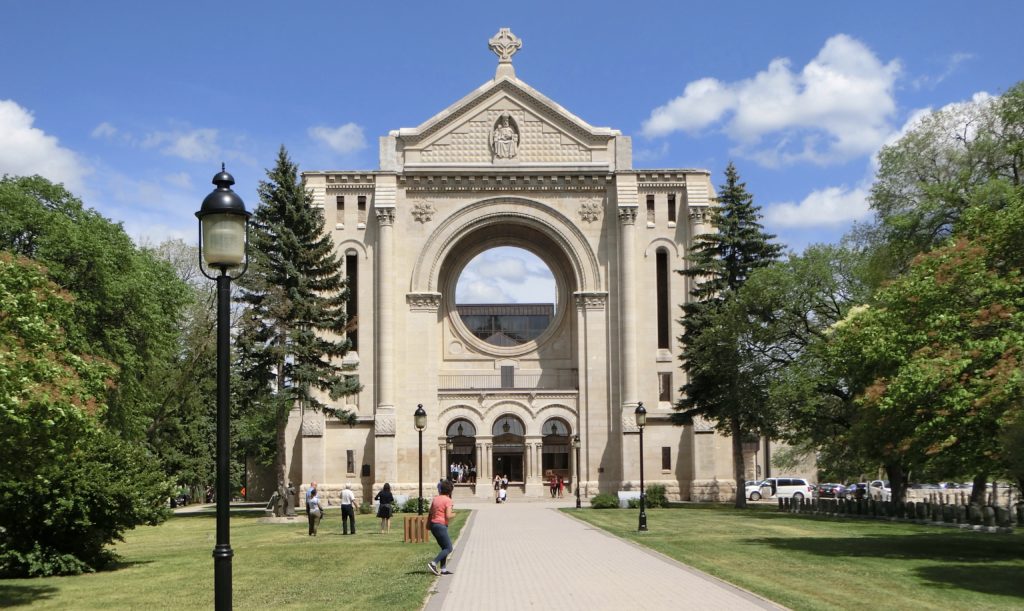Today was a bit different. Instead of driving for most of the day, we spent more of the time sight seeing.
When I came back from my shower I found Dennis ensconced in the Land Rover, cooking porridge with our camping neighbour, Frank. Frank and his wife, Margaret, are a really sweet couple. Frank is a Mennonite. His great grandfather emigrated to Canada. The Mennonites were invited, from various European countries, to settle in what was then, Southern Russia; now Ukraine, by Catherine the Great. They became successful farmers, but later were persecuted by the Russians, causing many to emigrate to Canada and other places.

As we were only about 40ks outside of Winnipeg, it didn’t take us long to get to the city centre. Two different people had warned us Winnipeg was not a nice city, even dangerous. Apparently drugs are a problem. We were only in the downtown area and didn’t see any signs of any problems, but all cities have their less salubrious areas.
Frank had recommended the one thing we must see was the Museum for Human Rights. It wasn’t difficult to find, being a very distinctive, contemporary architectural feature. It was designed by American architect Antoine Predock. It reminded me of the Guggenheim in New York. A similar style where you visit exhibits winding up in a spiral. Only this is an angular spiral. The museum explores all aspects of human right’s issues.

Most relevant to Canada being the forcing of Aboriginal children into residential schools. There were some recorded harrowing interviews with people. Not only had they been forcibly removed from their parents, but badly treated as well. Malnourished and abused. Physically, mentally and sexually. Quite appalling. Another issue relevant to Canada is the disappearance of women. Mainly Aboriginal. We noticed when we were in the North, frequent signs in shops and on notice boards appealing for information on the whereabouts of various missing women. Apparently domestic abuse is a problem in the Aboriginal community. That cannot be surprising, though, when you consider the upbringing many Aboriginals have endured.
After visiting the museum we returned to the Land Rover and as we had plenty of food on board had a picnic in the car park.
Next a visit to The Forks. This is the historically significant meeting place of the small, muddy Assiniboine River and the large, muddy Red River. The area has been beautifully landscaped with gardens, walking paths and sign boards with historic information. The Forks was a meeting place for the various Aboriginal tribes for centuries and later for the trappers, fur traders and other settlers. Winnipeg was, in the 19th century, the centre for fur trade rivalry between the Hudson Bay Company and the North West Company. The rivers enabling travel from different parts of the country.
We crossed the Red River and stopped in the French quarter of St. Boniface to visit the St. Boniface Basilica. An odd looking building from the road. However, we soon realised what we could see was mainly the remaining white stone facade. The Basilica was mostly destroyed by fire in 1968 and a more modern structure has been erected on the ruins. Viewed from the front this can be seen through a large circular hole in the stone facade. Presumably, originally, a stained glass window.

We started to head in the direction of Kenora. I should add that the scenery has reverted to extremely flat. It is more attractive than Saskatchewan though and the trees are now mainly a type of oak. Soon we saw a sign for a Heritage Mennonite Village. A diversion of 10 ks off Highway 1 at Steinbach. It turned out to be 20 ks, but was worth the visit. It was almost 4.30 when we arrived and the Village was due to close at 5. The lovely lady at reception said she would only charge us half price for such a short visit and let us have a golf buggy, so we could nip around quickly. This we did with Dennis driving the buggy, backwards as well as forwards to manoeuvre us in and out of buildings, at a rate of knots. We managed to see pretty much everything. The houses and barns, school, church, farm buildings and a lot of old equipment. Even managing to walk through some of the houses, all furnished with the original furnishings. A couple of days ago we had seen a black horse pulling a black, covered buggy coming towards us on the opposite side of the highway. We learned at the Heritage Village that there are just a few communities where the old way of life is still practiced. Gladstone is one such place and we had just passed it at the time of seeing the buggy.
The very helpful lady at the Village said she would give us details of local camping. She had photocopied the address and rates for us and marked the location on a map and gave us the details as we left. The camp was located at a Golf and Country Club and was nice and quiet. Hopefully a good night’s sleep will follow.
Views: 42
